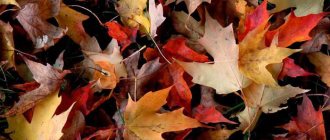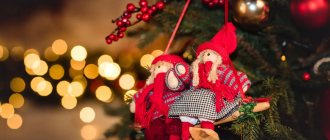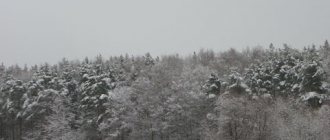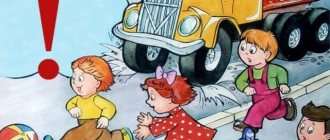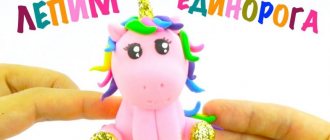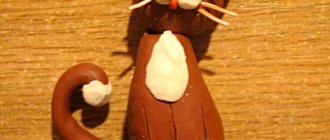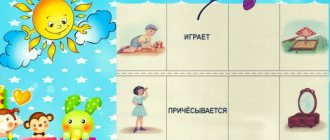Article topic "Telling from the picture" Dog with puppies "". Author: Zhurina Anna Viktorovna
Author: Zhurina Anna Viktorovna Teach children to describe a picture, compose a short story based on the teacher’s model. Continue to teach children to answer the teacher’s questions. Help children coordinate words in a sentence. Improve the ability to correctly use prepositions in speech.
Author: Anna Viktorovna Zhurina Summary of educational activities for the development of speech in a senior correctional group Topic: Storytelling based on a picture Dog with puppies Prepared by: Anna Viktorovna Zhurina, teacher of the highest qualification category Purpose: to teach children to describe a picture in a certain sequence, to name the picture. Objectives: Speech development: Teach children to describe a picture, making up a small, coherent story based on the teacher’s model. Continue teaching children to answer the teacher’s questions. Help children coordinate words in sentences. Improve the ability to correctly use prepositions in speech. Continue learning to form the plural form of nouns denoting baby animals. Learn to use the most common adjectives, verbs, adverbs, and prepositions in speech. Learn to listen to other children's answers. Cognitive development: Develop memory, attention, thinking. Social and communicative development: Cultivate a caring attitude towards animals, friendly relationships between peers. Materials and equipment: a toy - a dog, leaves on strings for breathing exercises, a painting of a Dog with puppies (Pets series by S. A. Veretennikova), easel, Lego set. Musical accompaniment: song Man is a dog's friend (poems by M. Libin, music by V. Komarov) Progress of the OD The teacher in the morning, before the OD, brings the painting Dog with Puppies into the group, places it on the easel and leaves it for the children to examine independently. When looking at the picture, children exchange impressions and manage to notice many details. At the request of the teacher, the children come up with a name for the picture. 1. Organizational moment. Children with a teacher are sitting on the carpet. Educator: Guys, you have already noticed that such a picture appeared in our group today. (The teacher draws the children’s attention to the easel where the painting is located.) Guess the riddle and find out who brought it to us. The teacher asks a riddle: He is friends with the owner, guards the house, lives under the porch, has a tail like a ring. (Children's answers.) The teacher brings a puppy toy into the group. The children greet him. They pet him. Educator: This puppy came running to visit us today and brought a painting with him. He was so sad. I asked what happened. He answered me that this picture hangs in his house, in his booth, he likes it so much, but he cannot tell his friends what is depicted in it, because he does not know how to tell a story from the picture. That's why he came running to us for help. Guys, can we help the puppy? (Children's answers.) In order for our story to be correct and understandable, we will do breathing exercises. Breathing exercises Let's blow on the leaves Wind (repeat 2-3 times) A strong wind suddenly blew, blew leaves from the trees. I. p. - exhale completely through your nose, drawing in your stomach and chest. 1 – take a full breath, protruding the stomach and ribs of the chest; 2 – hold your breath for 3-4 seconds; 3 – make the lips a tube, release the air. 2. Main part. Children sit on chairs in front of the easel. Educator: Children, first we must come up with a name for this picture. What is shown in the picture? (Individual answers.) What can you call the picture? The teacher listens to the children, corrects their answers, explains that the title of the picture should not be very long, but even from the short title it should be clear what the picture is about. The teacher approves of the following names: Dog and her puppies, Dog yard, About dogs, etc. Educator: I like the name Dog with Puppies. Explains what can be said with puppies, and what can be said with puppies. Educator: In order for the story based on the picture to be interesting, without repetition, you must first tell everything about the dog, then everything about the puppies and, finally, describe the yard itself. So, focus on the dog. The teacher asks leading questions: - What kind of mother is a dog? (Individual answers: big, shaggy, spotted); - What is she doing? (Choral answers: lying down, resting, looking after the puppies, etc.) After listening to the children, the teacher summarizes what was said and gives a sample story: This picture shows a dog with two puppies. The dog is large, shaggy, spotted. She lies and watches her puppies. Then he offers to talk about the puppies, asks clarifying questions, corrects the children’s answers, etc.: - Who is standing next to the dog? (Choral answers.) - Mom is a big dog, but what about the puppies? (Choral answers.) - What puppies? (individual answers: small, cheerful, funny, spotted) - What do puppies do? (Individual answers.) - Which puppy, (child’s name), do you like best? Tell me about him. (With the help of leading questions, the child tells what kind of puppy it is, where it is in relation to the mother dog and what it is doing.) - Who will tell about the other puppy? (The willing child also describes another puppy) After listening to the children, the teacher summarizes what was said and gives a sample story: Next to the dog is a small, fluffy puppy. He stuck out his tongue and looked at the sparrows that had arrived. A little further away there is another puppy. He is small, fluffy with his tail raised up. He also looks at the sparrows that have arrived. Educator: Now we need to describe the yard in which the dog and puppies live. The teacher makes sure that the children correctly designate spatial landmarks and specify where it is - there, here (near, nearby, in, at, etc.): - Where do dogs live? (choral answers.) - Who built the kennel for them? (individual answers.) - Who brought the dogs food? (choral answers.) - Who flew to them? (choral answers.) - What do sparrows do? (individual answers.) Educator: Well done, guys. Now listen to me talk about this picture. Example of a teacher: This painting shows a dog with two puppies. The dog is large, shaggy, spotted. She lies and watches her puppies. Next to the dog is a small, fluffy puppy. He stuck out his tongue and looked at the sparrows that had arrived. A little further away there is another puppy. He is small, fluffy with his tail raised up. He also looks at the sparrows that have arrived. Caring people built a kennel for them and brought food for them. They have eaten and are resting. Two sparrows flew to them. One sparrow pecks at their food, and the other looks at it. The puppies look at the sparrows arriving and think: “Who are they? Why do they peck at our food? It's good for the puppies to be with their mother! Children listen to the teacher's story. Then the teacher offers to tell 2-3 children about the picture (optional). Educator: Well done, the puppy really liked your stories and now he wants to play with you. Physical education lesson Carousel Children stand in a circle. Barely-barely-barely The carousel began to spin (the children begin to move slowly) And then, then, then Everything ran, ran, ran (the pace of speech and movement accelerates) They ran, they ran, They ran, they ran, Hush, hush, don’t rush. (the pace slows down) Carousel os-ta-no-vi-te (everyone stopped) One-two, one-two, So the game is over (everyone bows to each other). 3. Bottom line. Educator: Guys, the puppy says thank you very much for your help. Now he knows how to tell his friends what is shown in this picture. I suggest our guest build a kennel. Do you agree? (Children's answers.) Before this, let's stretch our fingers. Finger gymnastics. The thumb wants to sleep. We perform finger exercises, first with one hand, and then with the other. The fingers are unclenched, we pinch the thumb into a fist. Index finger - play, Clamp your index finger into a fist. The middle finger has fallen asleep. We clasp the middle finger into a fist. Nameless is already tired. We clasp our ring finger into a fist. Littlefinger shouts to everyone - “Hurray!” Clamp your little finger into your fist. It's time to go to kindergarten! We compress and unclench the fist. The children get to work to the song Man is a Dog's Friend. comments powered by HyperComments
Progress of the lesson:
- Good morning, guys! I am glad that you are so beautiful and cheerful today! Let's share our kindness with each other. Let's greet each other by passing our hearts around. First let's look at it. See how warm and beautiful it is. When you pass it to each other, turn to your neighbor and, looking at him, smile and say, for example, “Mashenka, I’m glad to see you, how beautiful and elegant you are today.”
.
After the greeting, the teacher asks a riddle:
-Why do you think this is a dog ? (Children prove)
-Yes, that's right - it's a dog . Look at the picture the dog sent .
The painting “ Dog with Puppies ” is hanging
.
Children look at it for 2-3 minutes .
Conversation on the painting .
-Who is depicted in the picture ? ( Dog with puppies , sparrows)
-What is the dog ? (Lies near his kennel house)
-Who is lying near the dog (Puppy)
Listen to me tell you .
-This puppy is small, colorful, funny, clumsy. His nickname is Pestrik because he is motley. He looks like his mother. His eyes are small, like beads. The nose is also tiny. The tail is brown, lifted up, and the ears are drooping. He stands and looks at the sparrows. I really like him.
- tell me about the other puppy.
Children's stories.
— The puppies are small, and their mother is a big , shaggy dog.
-What's in the dog ?
-Where are the dogs and puppies ?
-Where do dogs ?
-Who brought food to the dogs , who built a kennel for them?
-What would you call the picture ?
-And the artist called it “ Dog with puppies ”
.
All children and even adults dream of a small dog . Let us also play owner and little puppy. Let each of you think about who he will be - an owner or a puppy. Divide into pairs, agree on who will be who and come to me, owners. What commands can an owner give to his puppy? (Stop, lie down, run, jump, sit, dance)
The puppies are obedient, they will follow commands
(children can disperse throughout
the group in pairs ) After the game, share a story . If necessary, the teacher helps and suggests the beginning of a phrase. Answers 2-3 children.
- Guys, who has a dog or puppies ?
-What are they like? Tell us about them .
Okay, I’ll write your stories in a beautiful album, in the evening moms and dads will read it.
Guys, what are your mood now? What was your favorite thing to do? Go to the table and choose an emoticon according to your mood.
Summary of educational activities in the middle group in the field of “Speech development”.
Theme: “Telling a story based on the painting “Winter Fun”. b]Integration of educational areas: “Speech development”, “Cognitive development”, “Social and communicative”, “Physical development”.
Summary of OOD on speech development in the second junior group. Subject. Examination of the painting “Dog with Puppies”. Goal: Teach children to look at the picture. Objectives: Educational: Learn to answer the teacher’s questions and write a short story together.
Can a dog coloring page bark?
It is very easy to draw barking in the dog coloring book. Children can easily draw small clouds themselves and write letters in them, and if you are given the task of drawing a dog barking, you will probably be surprised when you see how the child sees it. Don't be lazy to play this game.
It is interesting to know that dog barking is similar to wolf barking, only dogs bark more often than howl, and wolves do the opposite. Dogs bark when they see their owner or play with him - this is for joy. Aggressive barking can be heard when a dog encounters a stranger. If the sound is low, it means she is belligerent. A joyful bark is louder.
